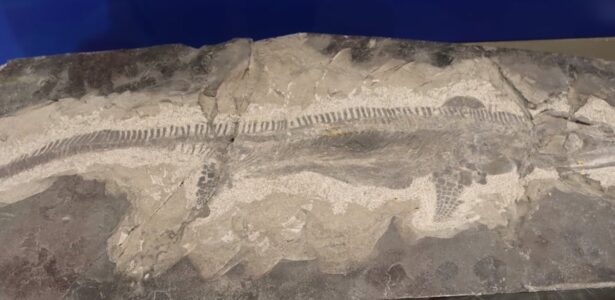Nel Triassico medio la regione alpina, occupata da una grande estensione di mare caldo, doveva avere un aspetto molto simile a quello che oggi troviamo alle isole Bahamas o nel Golfo Persico. In particolare a Besano e nell’area del Monte San Giorgio esisteva un bacino profondo fino ad un centinaio di metri. A nord, verso il Monte San Salvatore, il bacino era delimitato da una scogliera formata da alghe calcaree oltre la quale, verso Lugano, si estendeva una laguna delimitata da isolotti e vulcani. La quasi totale assenza di circolazione delle acque, soprattutto in prossimità del fondo, rendeva l’ambiente assai calmo, privo di correnti e povero di ossigeno. Gli organismi marini vivevano nelle parti più superficiali del bacino, regolarmente ossigenate. Le spoglie delle piante e degli animali che si depositavano sul fondo non venivano distrutte da altri organismi, essendo il fondale privo di vita, non venivano smembrate o disperse dalle correnti e venivano isolate dall’ambiente esterno grazie a una rapida sedimentazione. Ciò spiega l’eccellente conservazione dei fossili.
THE ANCIENT ENVIRONMENT
In the Middle Triassic period, the Alp region – then occupied by a large expanse of warm sea – must have been very similar to the current Bahamas or the Persian Gulf. A basin with depths of 330 ff was situated in Besano and in particular in the surroundings of Monte San Giorgio. To the north, toward Monte San Salvatore, the basin was bordered by a reef formed by calcareous algae beyond which, near Lugano, stretched out a lagoon delimited by little islands and volcanoes. The almost total absence of water circulation – especially near the seabed – made the environment very quiet, streamless and low in oxygen; marine organisms lived in the shallowest reaches of the basin, which were regularly oxygenated. Since the seabed was devoid of life, the remains of plants and animals deposited there were not destroyed by other organisms, nor were they dismembered and scattered by the current. Instead, they were isolated from the external environment by a rapid process of sedimentation, which explains the fossils’ excellent state of preservation.





